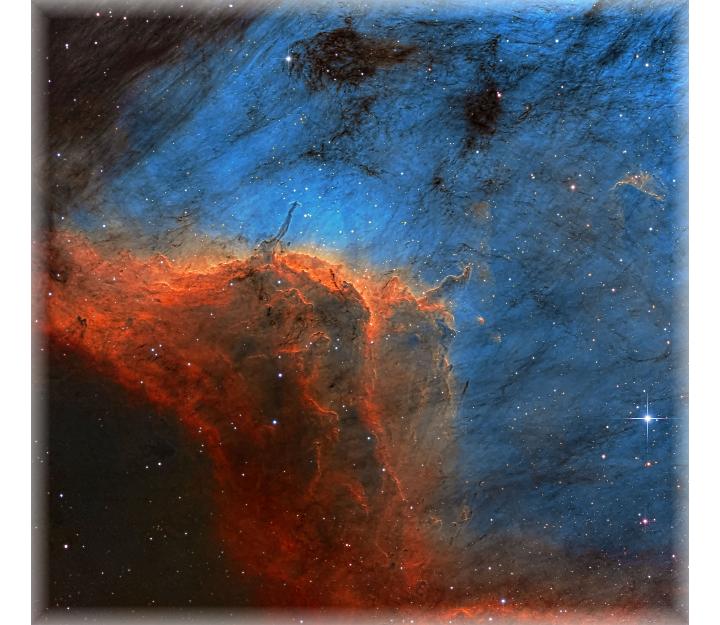 |
||
CITSO Blog: Birding in Cygnus
IC 5067 (Pelican nebula) in Cygnus
Imaged July 28 to August 11 2012, processed late 2014
Click the image for the high resolution version!


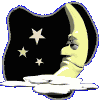


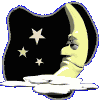






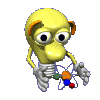




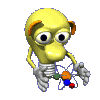










Birding in Cygnus
Pelican nebula, IC 5067 in Cygnus, in Narrowband Filters
Imaged between July 28 & August 11 2012, 17+ hours.
Processing completed December 31 2014.
Ha=290 minutes (1X1), SII=370m (2X2), OIII=360m (2x2), Subs=10m/20m.
Telescope=PlaneWave CDK17, Camera=Apogee U16M, Mount=Paramount ME.
Astrodon filters and MOAG, Starlight Xpress Lodestar guide camera.
Frames acquired with ACP controlling TheSky X, MaxIm DL, and Focusmax.
Processed with PixInsight, Photoshop, PhotoNinja, Noiseware, CCDInspector.
This is my second all-narrowband image, the result of 7 nights of imaging that straddled the full Moon, including on the eve of full Moon! This is the longest total exposure by far of any image that I've taken so far, and with good reason, owing to the weakness of the SII and OIII channels. I shot more than 22 hours all together, but only kept the best 17 hours for processing. The field of view is about 3/4 of a degree, and the final pixel size is 1" (the full frame was downsampled by a factor of 2/3 owing to limited seeing conditions).
I framed my image of the Pelican nebula with the "pelican" structure right of centre, and have given emphasis instead to another part of the nebular complex, which I placed near the top left "third" of the frame; this structure, with its long neck and angled head, looks to me like a Little Blue Heron catching a fish. So I call this image Birding in Cygnus, with a heron and a pelican lying inside the great swan ;).
As with my first narrow-band image (the Wizard nebula), I found that pleasing and comparatively "natural" colours resulted by (roughly) mapping SII as red, Ha as orange, and OIII as cyan. More precisely, I mapped the colors using the linear combinations Red=0.8*SII+0.2*Ha, Green=0.2*Ha+0.8*OIII, and Blue=OIII, while desaturating the stars as much as possible.
APOD features a number of beautiful renditions of the Pelican; I was strongly influenced by the beautiful work of Martin Pugh. As usual, APOD gives a short and sweet description of the physics of this scene: "Fantastic, dark shapes inhabiting the view are clouds of cool gas and dust sculpted by energetic radiation from young, hot, massive stars. But stars are also forming within the dark shapes. In fact, twin jets emerging from the tip of the long, dark tendril (HDT: the little blue heron!) ... are the telltale signs of an embedded protostar cataloged as Herbig-Haro 555. The Pelican Nebula itself ... is about 2,000 light-years away. To find it, look northeast of bright star Deneb in the high flying constellation Cygnus."
Incidentally, here is a neat annotated close-up of Hebig-Haro 555 in an image of the Pelican by the National Optical Astronomy Observatory.
I found this to be a very tough image processing challenge, given that the entire frame is blanketed by nebulae, with most of the structures showing up with highest contrast in the weak SII channel. I was very frustrated by my initial attempt at processing in the fall of 2012, and I abandoned the image for two years! By the fall of 2014 I had poured over a new book on astronomical image processing, "Lessons from the Masters: Current Concepts in Astronomical Image Processing", edited by Robert Gendler, with chapers written by some of the finest imagers, most of whom rely on Photoshop. I had stopped using Photoshop in early 2011, and had relied exclusively since then on PixInsight. It was clear that Photoshop has evolved dramatically since then, with many new and revamped tools that are very powerful for astronomical image processing (not to mention the convenience of Photoshop's WYSIWYG interface). Anyway, long story short, I took this complex image as an opportunity to relearn and apply Photoshop techniques, in combination with some of the powerful processing tools in PixInsight. The result exceeded my hopes, and going forward, Photoshop will be a core part of my processing toolkit!
DownX2 for Asterik


Copyright © 2014 Howard Trottier





